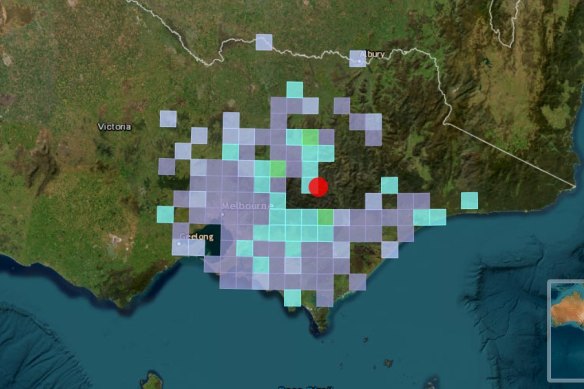Australian cities would get no warning of big earthquake

Save articles for later
Add articles to your saved list and come back to them any time.
Australia’s major cities would have no advanced warning if a huge earthquake were to strike, because unlike California and Japan, we do not have an early warning system.
However, scientists say there are major technical questions about installing one here – and the cost would be enormous, especially compared to the lack of damage most Australian earthquakes do.
A magnitude 4.6 earthquake struck in eastern Victoria Friday morning, shaking people across the state, including in Melbourne.Credit: GeoScience Australia
If those hurdles could be surmounted, an early warning system would at most provide a few seconds’ notice.
Melburnians only knew about the 4.6 magnitude quake that struck eastern Victoria at 1.30am Friday – an aftershock of the large 2021 Woods Point quake – when they felt the earth shake.
In earthquake-prone California, a network of instruments sends smartphone alerts to people before an earthquake, potentially giving them time to ‘drop, cover and hold on’. Japan operates a similar system that can automatically shut down critical infrastructure, such as bullet trains.
China’s warning system is the world’s largest. A video posted online by the country’s state broadcaster shows the system triggering blaring loudspeaker alarms.
Unlike volcano monitoring, none of these systems can actually predict an earthquake.
Instead, they listen for the P wave, the first seismic wave caused by an earthquake. The P wave is the fastest-travelling wave, but causes only a small amount of shaking.
It is followed by the slow-moving but much more dangerous S wave. The gap between the P and the S wave can be tens of seconds, allowing for a quick warning to be put out.
“You’re talking about tens of seconds between the P and S wave,” said Professor Phil Cummins, an earthquake researcher at the Australian National University.
“This isn’t much time. And it’s arguable whether it’s enough time for people to leave buildings – and whether they should do that.”
Public health advice during an earthquake is for people to remain inside while the building is shaking – leaving can put you at risk of falling debris or being injured in any ensuing panic.
Early warning systems are most useful for people operating hazardous machinery, Cummins said. Utility companies use the time to shut gas mains and cut power to machines that could explode if damaged. Surgeons could also stop operating.
“You really need to be careful about not panicking people. This is really only effective for operators of critical infrastructure or critical equipment, for which operations can be stopped quickly,” Cummins said.
But buying those precious few seconds is difficult and expensive.
Seismometers must be placed close to the quake epicentre to be effective. This works in California, where fault lines are well known.
But Australia is large and covered in undetected fault lines.
“We do know some active faults. But we don’t know all of them. I don’t think anyone will tell you they have a good idea where the next large earthquake will occur,” said Cummins.
The country’s largest-ever earthquake on land, a 6.6 magnitude shaker that hit Tenant Creek in 1988, is “a prime example,” said Jonathan Bathgate, duty seismologist at Geosciences Australia.
“We’d never seen any earthquakes there before. There was no indication it’s going to be geologically active.”
Even large earthquakes rarely do much damage. The effects of Victoria’s largest quake, which struck Woods Point in 2021, were largely limited to knocking the facade off a burger shop.
Quakes that damage towns and claim lives, like Newcastle’s 5.6 magnitude in 1989, are thankfully rare.
To install an early warning system here, you’d need to cover the continent in sensors. California has deployed over 900 stations across its 423,000 square kilometres, and its fault lines are well known. Australia stretches more than 7.6 million square kilometres.
“If we had something like that, it would be a very large undertaking. We’ve got a lot of ground to cover, and a lot of instruments to install,” said Bathgate.
Liam Mannix’s Examine newsletter explains and analyses science with a rigorous focus on the evidence. Sign up to get it each week.
Most Viewed in National
From our partners
Source: Read Full Article
